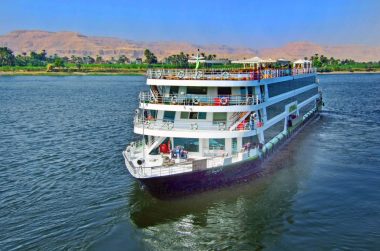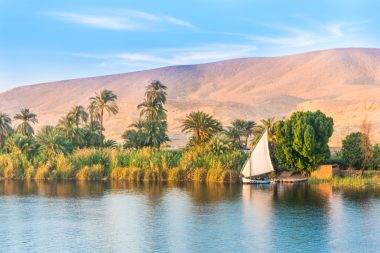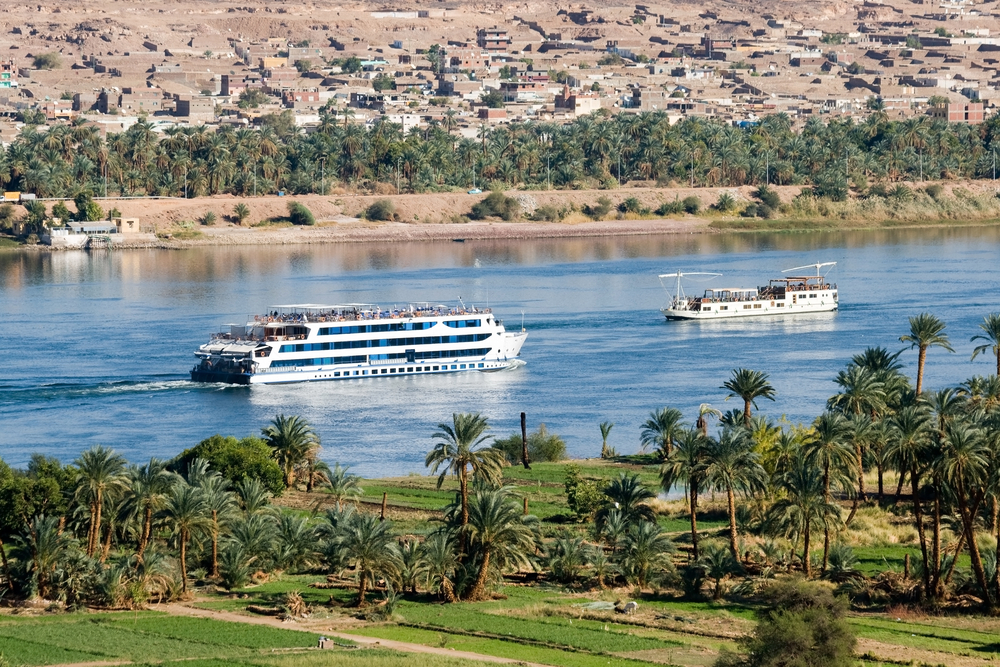No other country in the world is so intensively shaped by a single river. Egypt – that is the Nile, the origin of all life and a gift from heaven for the people on its banks. If you decide to take a Nile cruise, you will immerse yourself deeply in history, because this river is the source of an incomparable high culture and a river for eternity. This is the lifeline of great dynasties from the period of the pharaohs. Leisurely and without any hurry, the passengers of a Nile cruise sail past gigantic pyramids and testimonies of a sunken world. The realm of the dead has preserved its myth to this day, and a passage on the Nile has always been an experience of an extraordinary kind.
The glory of the pharaohs has stood the test of time

For a long period of history, the empire of the pharaohs lay in the fog of oblivion. It was Napoleon Bonaparte’s campaign into Egypt that aroused curiosity and longing among Europeans on the threshold of the 19th century. “All great fame comes from the banks of the Nile and from this part of the Orient,” Bonaparte let it be known, and probably did not suspect that he was triggering a boom in the Old World. Those who were well-heeled travelled to Egypt from then on. And little has changed to this day, because anyone who boards a modern ship in the capital Cairo can look forward to an unforgettable journey. The glory of the pharaohs has stood the test of time. More than any other culture on the planet.
The Egyptians’ longing for immortality
The wonders on the banks of the Nile are as mysterious as ever, and their massive tombs were understood by the people of ancient Egypt as their very personal homes for eternity. In their graves, the dead achieved immortality. The ideas of belief in the gods and of the afterlife were the driving forces for artistic creation and for the gigantism of numerous buildings. The Egyptians’ longing for life in another sphere determined people’s actions and thoughts over a long period of history. On the outskirts of Cairo, the hustle and bustle disappears, and at the latest on board a modern cruise ship, guests feel more than just a hint of peace and seclusion.
On the Nile cruise to the historic “Valley of the Kings” near Luxor

Presumably, the time of a cruise on the Nile is not enough to visit all the historical sites extensively. And so the majority of providers of Nile cruises limit themselves to the highlights on the banks of the longest river on the African continent. The palaces and temples of ancient Thebes, which can now be found on maps as “Luxor”, are located on the eastern bank of the river. If you decide to go to the city of the dead, you have to cross over to the western bank. Numerous passengers on a Nile cruise get into the seats of the horse-drawn cabs and are chauffeured to the temple of Karnak, the temple complex of the god Amun. For a period of two millennia, Karnak was the most important sanctuary of ancient Egypt. The temple complex of Luxor is very well preserved. Today, the ancient city is the starting point of Nile cruises downstream. In the vicinity of Luxor, the legendary “Valley of the Kings” begins, where 65 pharaohs’ tombs – including that of the young regent Tutankhamun – were discovered in a mountain massif.
Thanks to UNESCO, Abu Simbel was saved
One of the most magnificent paintings in the “Valley of the Kings” is the tomb of the Nefertari. Some passengers on a Nile cruise refrain from hiking along dusty paths at the interesting settlement of the necropolis workers and instead let themselves be taken to the historic graves in the saddle of a donkey. Another highlight of a cruise on the great river is a visit to the Nile island of Elephantine with its beautiful museum. But the rock tombs of Aswan are also worth noting. The place gained a lot of attention when the construction of the huge Nile dam began in the middle of the 20th century and not only some Nubian villages sank into the masses of water. There was a danger that the imposing temples of Abu Simbel, 290 kilometers south of Aswan, would fall victim to the dammed water of the Nile. UNESCO finally saved the temples of Ramses II. The relocation of the shrine was a joint effort of many nations in five years of work. All colossal statues were given a new place undamaged.
Thirty dynasties and a 5000-year-old history
For more than thirty dynasties, the pharaohs ruled their empire on the banks of the Nile. Historians still find it difficult to understand what happened over such a long period between Alexandria on the Mediterranean Sea and the great rock temples of Abu Simbel and what everyday life was once like for the people there. After all, scientists deciphered the hieroglyphics, which the Greeks once believed to be a kind of “cipher”. The Frenchman Jean François Champollion finally found the solution and made an important contribution to understanding the realm of the dead of the Egyptians and their inscriptions in the tombs. And a cruise on the stream of life is an encounter with five thousand years of history of this interesting country. On board, passengers are spoiled with culinary delicacies and provided with a lot of information. A cruise on the Nile is the key to understanding this enigmatic period of Egyptian history.


